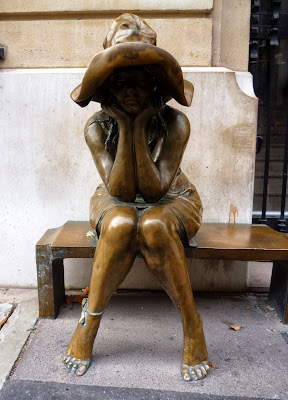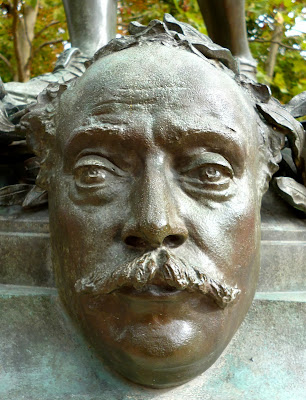Vassilis Alexakis's lovely novel L'Enfant grec makes many digressions, and I shall be making some of my own to illustrate the areas he covers, putting in brackets things he doesn't mention.
Alexakis's novel is also very autobiographical. It concerns an (unnamed) old man who has had a major leg operation in Aix-en-Provence and must now walk on crutches until his leg heals. Due to his mobility problems he can't immediately return to his flat in the 15th arrondissement, so he is temporarily living in L'hôtel Perreyve in rue Madame, very close to rue Fleurus and close to a western entrance to the Jardin du Luxembourg in the 6th arrondissement. The name of the hotel and the streets are real, as are the narrator's geographical details.
At one point the narrator and his companions turn from rue Guyemer (which borders the western edge of Luxembourg), cross rue de Vaugirard and take a few steps into rue Napoléon, where the narrator becomes very interested in the bronze woman with the hat and even joins her on her seat outside L'Institut hongrois.
(On her ankle is the creator's signature: it is by Andràs Lapis and there's a copy of it in Szeged in Hungary. The original was made in 1975, although this particular sculpture dates from 1992.)
(And 'Kala palati', inscribed on the brim of the hat, is the title of the sculpture, which apparently means something like 'Under the Hat'.)
Much of L'Enfant grec – along with the memories of the narrator on crutches – is set in the Jardin du Luxembourg. The recuperating man now sees things at a much slower pace, a world in a grain of sand: he has time to reflect on his now slow present, and on his past.
The narrator often mentions L'Auberge des Marionnettes in the Jardin du Luxembourg, although there is no such establishment. But there is a place called La Buvette des Marionnettes, which is very near the marionnette theatre.
And the Buvette even has a menu including two puppets Alexakis frequently mentions in the novel: Guignol and Gnafron.
L'Enfant grec is a wonderful (if often wildly imaginative) guide to the Jardin du Luxembourg. The narrator mentions the statue of a boy ('Le Marchand des masques') to the south-east of Luxembourg near L'École des Mines, with its several masks at the boy's feet.
There, Balzac – who the narrator says disliked the Jardin (and implies that that is a reason why there's no statue or bust of him here) – makes an obscure appearance as a mask.
Alexandre Dumas is also there.
And so too is Barbey d'Aurevilly.
Significant here is that the boy holds up a mask of Victor Hugo. The title of Alexakis's book, L'Enfant grec, comes from Hugo's poem 'L'Enfant', about a child left in the ruins of Thios after its destruction by the Turks in 1822. Several times in this novel, Alexakis mentions the Sénat in the Jardin du Luxembourg, to which Hugo belonged from 1876–85. And throughout the novel we are reminded of the young Greek narrator's reading habits – Hugo's Les Misérables, or Defoe's Robinson Crusoe, or Stevenson's Treasure Island, or many more classics. (He also speaks of the financial ruins of contemporary Greece.)
The novel is a cross between a guide – historical and modern – to the Jardin du Luxembourg, a guide to the narrator's thoughts and memories, and to his fantasies. It may be immensely digressive, but so too are many good books. And this is undeniably a very good book.

–––––––––––––––––––––––––––––––––––



















No comments:
Post a Comment